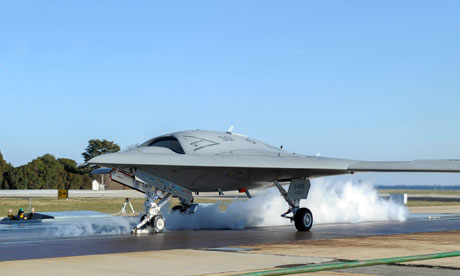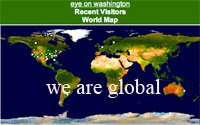From Truth-out.org, by Dr. Ellen Brown, 2-24-13. Read link here.
As QE is practiced today, the money created on a computer screen never makes it into the real, producing economy.
Quantitative easing (QE) is supposed to stimulate the economy by adding money to the money supply, increasing demand. But so far, it hasn't been working. Why not? Because as practiced for the last two decades, QE does not actually increase the circulating money supply. It merely cleans up the toxic balance sheets of banks.
A real "helicopter drop" that puts money into the pockets of consumers and businesses has not yet been tried. Why not? Another good question.
When Ben Bernanke gave his famous helicopter money speech to the Japanese in 2002, he was not yet chairman of the Federal Reserve. He said then that the government could easily reverse a deflation, just by printing money and dropping it from helicopters.
"The US government has a technology, called a printing press (or, today, its electronic equivalent)," he said, "that allows it to produce as many US dollars as it wishes at essentially no cost." Later in the speech, he discussed "a money-financed tax cut," which he said was "essentially equivalent to Milton Friedman's famous 'helicopter drop' of money." Deflation could be cured, said Friedman, simply by dropping money from helicopters.
It seemed logical enough. If the money supply were insufficient for the needs of trade, the solution was to add money to it. Most of the circulating money supply consists of "bank credit" created by banks when they make loans. When old loans are paid off faster than new loans are taken out (as is happening today), the money supply shrinks. The purpose of QE is to reverse this contraction.
But if debt deflation is so easy to fix, then why have the Fed's massive attempts to pull this maneuver off failed to revive the economy? And why is Japan still suffering from deflation after 20 years of quantitative easing?
On a technical level, the answer has to do with where the money goes. The widespread belief that QE is flooding the economy with money is a myth. Virtually all of the money it creates simply sits in the reserve accounts of banks.
That is the technical answer, but the motive behind it may be something deeper.
An Asset Swap Is Not a Helicopter Drop
As QE is practiced today, the money created on a computer screen never makes it into the real, producing economy. It goes directly into bank reserve accounts, and it stays there. Except for the small amount of "vault cash" available for withdrawal from commercial banks, bank reserves do not leave the doors of the central bank.
According to Peter Stella, former head of the Central Banking and Monetary and Foreign Exchange Operations Divisions at the International Monetary Fund:
Banks do not lend 'reserves....' Whether commercial banks let the reserves they have acquired through QE sit 'idle' or lend them out in the internet bank market 10,000 times in one day among themselves, the aggregate reserves at the central bank at the end of that day will be the same.
This point is also stressed in Modern Monetary Theory. As explained by Prof. Scott Fullwiler:
Banks can't 'do' anything with all the extra reserve balances. Loans create deposits; reserve balances don't finance lending or add any 'fuel' to the economy. Banks don't lend reserve balances except in the federal funds market, and in that case the Fed always provides sufficient quantities to keep the federal funds rate at its ... interest rate target.
Reserves are used simply to clear checks between banks. They move from one reserve account to another, but the total money in bank reserve accounts remains unchanged. Banks can lend their reserves to each other, but they cannot lend them to us.
QE as currently practiced is simply an asset swap. The central bank swaps newly created dollars for toxic assets clogging the balance sheets of commercial banks. This ploy keeps the banks from going bankrupt, but it does nothing for the balance sheets of federal or local governments, consumers or businesses.
Central Bank Ignorance or Sabotage? Another Look at the Japanese Experience
That brings us to the motive. Twenty years is a long time to repeat a policy that isn't working.
UK Professor Richard Werner invented the term quantitative easing when he was advising the Japanese in the 1990s. He says he had something quite different in mind from the current practice. He intended for QE to increase the credit available to the real economy. Today, he says:
All QE is doing is to help banks increase the liquidity of their portfolios by getting rid of longer-dated slightly less liquid assets and raising cash.... Reserve expansion is a standard monetarist policy and required no new label.
Werner contends that the Bank of Japan (BOJ) intentionally sabotaged his proposal, adopting his language, but not his policy; and other central banks have taken the same approach since.
In his 2003 book Princes of the Yen, Werner maintains that in the 1990s, the BOJ consistently foiled government attempts at creating a recovery. As summarized in a review of the book:
The post-war disappearance of the military triggered a power struggle between the Ministry of Finance and the Bank of Japan for control over the economy. While the ministry strove to maintain the controlled economic system that created Japan's post-war economic miracle, the central bank plotted to break free from the ministry by reverting to the free markets of the 1920s....
They reckoned that the wartime economic system and the vast legal powers of the Ministry of Finance could only be overthrown if there was a large crisis - one that would be blamed on the ministry. While observers assumed that all policy-makers have been trying their best to kick-start Japan's economy over the past decade, the surprising truth is that one key institution did not try hard at all.
Werner maintains that the Bank of Japan not only blocked the recovery, but actually created the bubble that precipitated the downturn:
Those central bankers who were in charge of the policies that prolonged the recession were the very same people who were responsible for the creation of the bubble....They ordered the banks to expand their lending aggressively during the 1980s. In 1989, [they] suddenly tightened their credit controls, thus bringing down the house of cards that they had built up before....
With banks paralyzed by bad debts, the central bank held the key to a recovery: Only it could step in and create more credit. It failed to do so, and hence the recession continued for years. Thanks to the long recession, the Ministry of Finance was broken up and lost its powers. The Bank of Japan became independent and its power has now become legal.
In the US, too, the central bank holds the key to recovery. Only it can create more credit for the broad economy. But reversing recession has taken a backseat to resuscitating zombie banks, maintaining the feudal dominion of a private financial oligarchy.
In Japan, interestingly, all that may be changing with the election of a new administration. As reported in a January 2013 article in Business Week:
Shinzo Abe and the Liberal Democratic Party swept back into power in mid-December by promising a high-octane mix of monetary and fiscal policies to pull Japan out of its two-decade run of economic misery. To get there, Prime Minister Abe is threatening a hostile takeover of the Bank of Japan, the nation's central bank. The terms of surrender may go something like this: Unless the BOJ agrees to a 2 percent inflation target and expands its current government bond-buying operation, the ruling LDP might push a new central bank charter through the Japanese Diet. That charter would greatly diminish the BOJ's independence to set monetary policy and allow the prime minister to sack its governor.
From Bankers' Bank to Government Bank
Making the central bank serve the interests of the government and the people is not a new idea. Prof. Tim Canova points out central banks have only recently been declared independent of government:
Independence has really come to mean a central bank that has been captured by Wall Street interests, very large banking interests. It might be independent of the politicians, but it doesn't mean it is a neutral arbiter. During the Great Depression and coming out of it, the Fed took its cues from Congress. Throughout the entire 1940s, the Federal Reserve as a practical matter was not independent. It took its marching orders from the White House and the Treasury - and it was the most successful decade in American economic history.
To free the central bank from Wall Street capture, Congress or the president could follow the lead of Shinzo Abe and threaten a hostile takeover of the Fed unless it unless it directs its credit fire hose into the real economy. The unlimited, near-zero-interest credit line made available to banks needs to be made available to federal and local governments.
When a similar suggestion was made to Ben Bernanke in January 2011, however, he said he lacked the authority to comply. If that was what Congress wanted, he said, it would have to change the Federal Reserve Act.
And that is what may need to be done: Rewrite the Federal Reserve Act to serve the interests of the economy and the people.
Webster Tarpley observes that the Fed advanced $27 trillion to financial institutions through the TAF (Term Asset Facility), the TALF (Term Asset-backed Securities Loan Facility) and similar facilities. He proposes an Infrastructure Facility extending credit on the same terms to state and local governments. It might offer to buy $3 trillion in 100-year, zero-coupon bonds, the minimum currently needed to rebuild the nation's infrastructure. The collateral backing these bonds would be sounder than the commercial paper of zombie banks, since it would consist of the roads, bridges and other tangible infrastructure built with the loans. If the bond issuers defaulted, the Fed would get the infrastructure.
Quantitative easing as practiced today is not designed to serve the real economy. It is designed to serve bankers who create money as debt and rent it out for a fee. The money power needs to be restored to the people and the government, but we need an executive and legislature willing to stand up to the banks. A popular movement could give them the backbone. In the meantime, states could set up their own banks, which could leverage the state's massive capital and revenue base into credit for the local economy.



